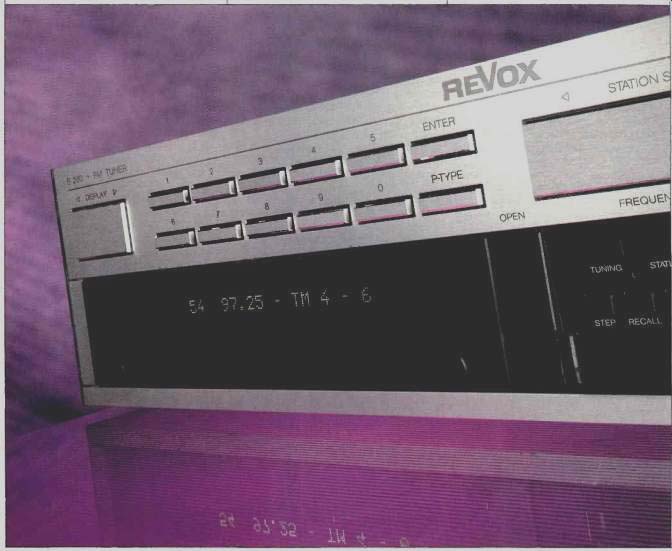
Manufacturer's Specifications:
Usable Sensitivity: 10.8 dBf.
50-dB Quieting Sensitivity: Single-r.f. mode -13.2 dBf in mono, 34.8 dBf in stereo; double-r.f. mode -16.7 dBf in mono, 38.3 dBf in stereo.
Selectivity: Wide, 50 dB; narrow, 100 dB.
Frequency Response: 20 Hz to 15 kHz, ±0.5 dB.
S/N: Greater than 80 dB.
THD: Mono, less than 0.07% at 1 kHz.
Muting Threshold: 2.0 Stereo Threshold: 10 µV.
Auto Tuning Threshold: Distant, 4 µV; local, 100 µV.
Stereo Separation: 43 dB at 1 kHz;
15 dB in Blend 1; 7 dB in Blend 2.
Calibration Tone: 400 Hz at 40 kHz equivalent deviation.
Power Requirements: 120 V a.c., 50/60 Hz; 20 watts, 5 watts standby.
Dimensions: 17.7 in. W x 4.3 in. H x 13 in. D (45 cm x 10.9 cm x 33.2 cm).
Weight: 15.4 lbs. (7 kg).
Price: Tuner, $2,500; B208 remote control, $160.
Company Address: 1425 Elm Hill Pike, Nashville, Tenn. 37210, USA.
There aren't too many over-$2,500 FM tuners out there anymore. I'm told that the old Sequerra tuners, which sold for that much and more, are still being made, but the Marantz 10B that started it all is not. So when I came across one (old FM buff that I am), my first inclination was to try to determine if the price was justified. After all, FM reception quality is ultimately limited by FCC broadcast standards set more than 40 years ago and amended for stereo in 1961.
You can't, for instance, receive audio frequencies above 15 kHz, and usable sensitivity is limited by the thermal noise floor of the antenna input impedance. So what makes a tuner like the Revox B260 worth $2,500? Plenty-but most of it has to do with convenience features and the tuner's ability to tailor reception specifically to the environment and signal conditions prevailing in your location.
Let's begin with some of the more innovative features. You can preset up to 60 stations. That may well be more than the number of presets that any other tuner can memorize, but as I see it, the real benefit is the ability to divide those memorized station frequencies into subgroups. Suppose you like jazz and classical but your spouse or roommate prefers soft rock and theater musicals. You could find all the stations that transmit your kind of music and store them under one subgroup heading, while the preferred stations of other household members could be stored under other subgroup headings. As many as nine subgroups can be organized and stored on the B260. Of course, all of the more conventional tuning modes are available, such as scanning (with brief auditioning as each usable signal is encountered), direct call-up of memorized stations, scanning within subgroups, and manual tuning. Another interesting feature is called "Auto Tune." It is a one-touch, initial setup programming system in which you need only tune in a station, touch one button, and the next available preset location is automatically assigned to the new station.
Besides station frequencies, the preset memories hold whatever settings you use to tailor the tuner's operation to your specific needs and preferences, so you don't have to go through all those switches and adjustments every time you call up the stations. Even the tuner's output level can be set separately for each station, so you can use the same volume setting whether you're listening to a quiet classical station or one of those stations which tries to be loudest on the dial by modulating up to (or beyond) the legal limits.
Information can also be programmed about which of the B260's two antenna inputs should be selected for each preset station, as can the degree of stereo blend, i.f. band width, and even r.f. sensitivity. There are two r.f. gain set tings about 4 dB apart--just enough to make overly powerful stations, which might otherwise overload the front-end, usable again.
The B260 display area has provisions for entering the call letters associated with each of the station frequencies you memorize. Up to four characters can be memorized for each station. I haven't seen that on a tuner since Larry Schotz first introduced it on his memorable Micro/CPU 100 tuner design more than a decade ago, though some recent receivers also offer it.
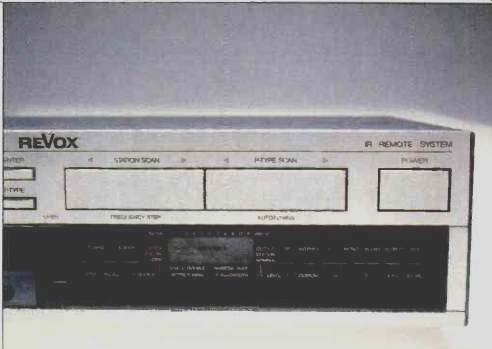
above: The B260's control panel could be used to teach a course in human
engineering.
Most home tuners let you switch to mono if stereo back ground noise or multipath interference becomes unbearable for a given signal, and some tuners feature a blend position which reduces noise at the expense of some stereo separation. The B260 offers two blend settings. One maintains about 15 dB of separation across the entire audio spectrum (not just reduced separation at high audio frequencies). The other provides only minimal separation (about 7 dB) for those situations in which most tuners would have to be switched fully to monophonic mode to make the back ground noise level tolerable.
To assist the user in setting up proper audio output levels for recording, there's a built-in calibration tone. As with most tuners having this feature, the tone's output is at the average level of most reasonable FM stations, equivalent to 40-kHz signal deviation.
It goes without saying that, while these convenience features are all well and good, they alone wouldn't provide sufficient justification for the high price of this FM tuner unless its sensitivity, selectivity, and other measured parameters were among the best available. Happily, they are, as you will see from my lab measurements and listening tests.
Control Layout
If I am ever asked to teach a course on industrial design and good human engineering, I think I will borrow a Revox B260 to illustrate how a tuner's front panel should be de signed. To begin with, the B260's low-profile design matches that of Revox's recently introduced 8250 integrated amplifier. Both units are about 1 1/2 inches lower than earlier Revox audio components, and will soon be available in black with gold trim instead of the company's traditional gray and silver.
The B260's programming controls are placed behind a hinged, smoked-glass cover, completely separated from the main operating controls. There is little chance of a child (or even you) accidentally upsetting previously programmed settings.
When the power switch at the extreme right of the panel is pushed, the tuner is turned on and the last received station is reactivated. Two large rocker pads just to the left are used for changing stations; their functions and illuminated labels change according to the setting of two buttons ("Tuning" and "Station") behind the smoked-glass panel.
In "Station" mode, the two rockers scan the preset memories. The right-hand rocker (now "P-Type Scan") scans up or down through the station subgroup, while the left-hand rocker ("Station Scan") scans up or down through all 60 programmed station memories, regardless of subgroup.
When the B260 is in "Tuning" mode, the right-hand rocker's label becomes "Autotuning," and it activates the automatic station scan, ascending or descending. The other rocker becomes "Frequency Step," and is used for manual tuning in steps of 10 or 50 kHz, as determined by one of the secondary controls. That 10-kHz step feature is extremely useful if you suffer from adjacent-channel interference, since it enables you to tune slightly away from the interfering sidebands of the adjacent-channel transmission without de-tuning enough to introduce serious distortion.
Small pushbuttons labeled "P-Type" and "Enter" set up the mode for entering a subgroup identification and activate the input function after retrieval or programming of a station memory or a program subgroup. Ten numerical keys are arranged across the upper left of the panel, along with a larger rocker labeled "Display." Pushing this pad changes part of the display area below, which can be cycled through to read station call letters, tuned-to frequency, or both.
(Station memory number and program subgroup number are always displayed.) A stereo indicator light is also part of this display, which occupies nearly the entire lower-left quarter of the panel.
The secondary controls referred to earlier are under the smoked-glass cover, which swings smoothly down and out of the way after a pushbutton labeled "Open" is depressed.
At the same time, a small secondary display, only dimly visible when the cover is up, becomes clearly visible amidst an array of secondary pushbuttons. A "Step" button selects 10- or 50-kHz frequency increments when you are in the manual tuning mode, which is selected by pressing the nearby "Tuning" button. Pressing the "Station" button, or closing the hinged lid, cancels the manual tuning mode. The "Recall" button restores the previously tuned frequency. A button labeled "Search" determines the signal-strength threshold that will apply during automatic tuning or scanning. Other small buttons select the antenna input desired, r.f. gain selection (local or distant), i.f. bandwidth, mono or stereo reception, stereo blend levels, muting, and such additional functions as are required for the sophisticated programming modes featured in this tuner. Two of the remaining buttons are used to access alphanumeric characters for setting up station call letters or whatever label you choose to program in. The small illuminated display, which shows up in this area when the hinged cover is lowered, is a multifunctional display that shows signal strength, center tuning, muting, antenna, mono mode, high-blend mode, search mode, audio level, i.f. bandwidth, and r.f. mode.
The rear panel houses the two antenna inputs, stereo output jacks, and a pair of jacks intended for connection to an oscilloscope for checking multipath during antenna orientation. There's also a multipin connector for use with Revox's multiroom infrared control receiver or their programmable controller when integrating the tuner with other Revox audio components. An optional wireless remote, the Revox B208, can control all the tuner's main functions, except "Display," when the tuner is in "Station" (automatic tuning) mode.
Measurements
Both of the B260's antenna inputs have impedances of 75 ohms, but neither uses the "F-type" connector we are accustomed to. Revox supplied an appropriate adaptor (to which a coaxial cable could be wired) as well as a "splitter," in case you want to connect your TV antenna or cable feed to the tuner as well. I used the adaptor to connect my 50-ohm generator output to the 75-ohm inputs, and I took that slight impedance mismatch into account in those measurements where it would significantly affect the results. (Normally, I use my generator's 300-ohm output, but the B260 has no 300-ohm input, and transformers would cause excessive signal losses.) Figures 1A and 1B are graphs of S/N ratio versus input signal level for the single-r.f. (distant) and double-r.f. (local) modes, respectively. (Since there was virtually no difference in quieting characteristics between the wide and narrow i.f. modes, I did not deem it necessary to re-plot these graphs for the narrow mode.) The chief differences between the results of Figs. 1A and 1B can be seen at low input-signal levels. For the distant mode, 50-dB quieting in mono was achieved with an input signal of 14 dBf, whereas with the double-r.f. setting, it took nearly 20 dBf of signal strength to reach the same -50 dB noise level. The difference was less profound in stereo, since stereo quieting inherently requires far more input signal to reach a noise level of -50 dB. In this case, it took exactly 38.0 dBf to reach that level of background noise using the distant setting, and 40 dBf in the local mode.
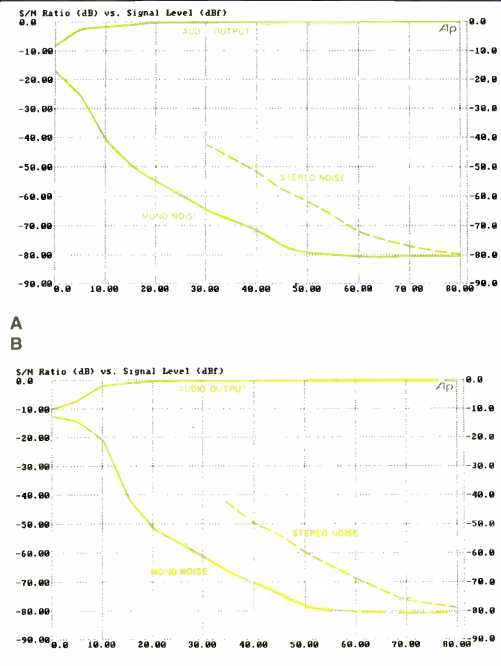
Fig. 1--Mono and stereo quieting characteristics, wide i.f. mode, for "Single
r.f." (A) and "Double r.f." (B) settings.
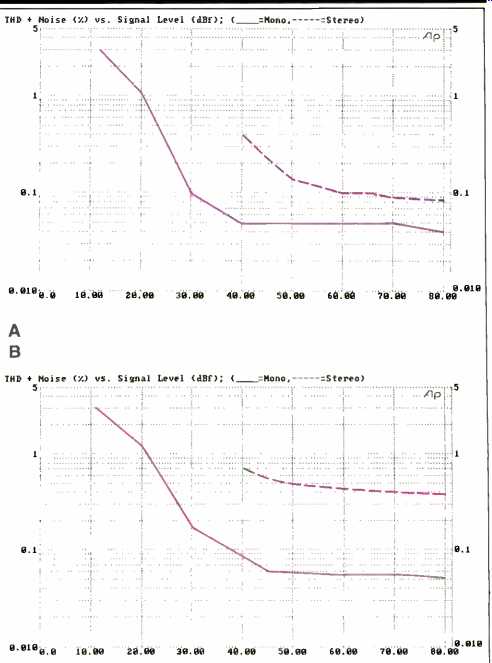
Fig. 2--THD + N vs. signal strength at 1 kHz for wide (A) and narrow (B)
i.f. modes.
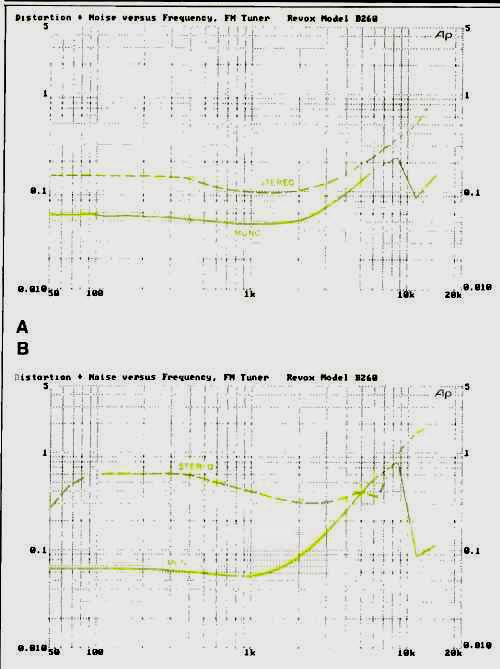
Fig. 3--THD + N vs. modulating frequency for wide (A) and narrow (B) i.f.
modes.
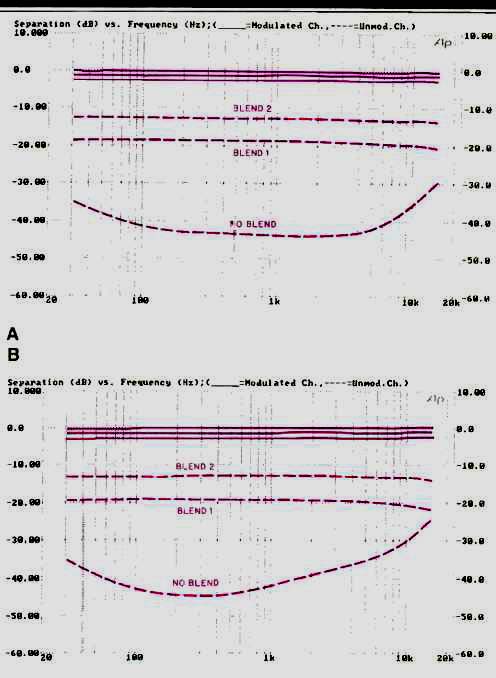
Fig. 4--FM frequency response (solid curves) and separation vs. frequency (dashed
curves) for wide (A) and narrow (B) i.f. modes. Note the two blend levels.
Solid curves are output with (top to bottom) no blend, Blend 1, and Blend
2.
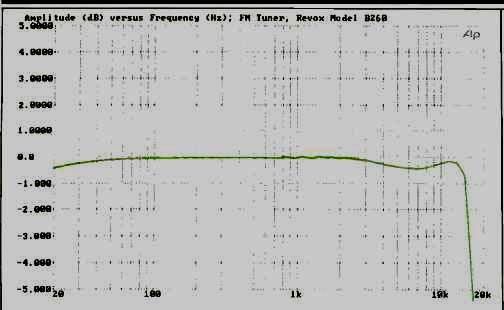
Fig. 5--Frequency response. Note vertical scale of 1 dB/div.
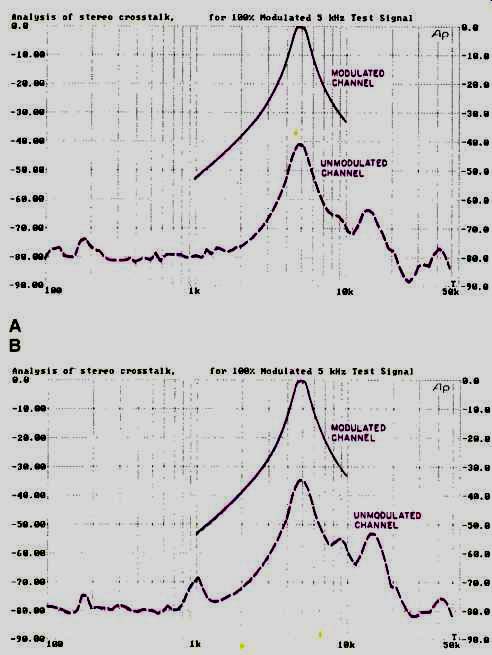
Fig. 6--Separation and crosstalk components for a 5-kHz modulating signal,
plus subcarrier and sideband components, for wide (A) and narrow (B) i.f.
modes.
Figures 2A and 2B show how THD + N varied with signal strength. (For this and all further tests, I used the distant mode.) From these graphs, you can see that the 3% point (usable sensitivity) was reached at a signal level of between 11.0 and 13.0 dBf, 'depending on whether the narrow or wide i.f. mode was employed. On my sample, the stereo switching threshold was set higher than specified, so I could not measure performance in stereo at signal levels below 30 dBf (for S/N measurements) or 40 dBf (for THD + N measurements). At strong signal levels, where THD + N is primarily THD, distortion for a 1-kHz signal measured 0.05% in mono for the wide i.f. mode and 0.055% for the narrow mode. In stereo, THD reached a low point of about 0.09% in the wide mode and about 0.4% in the narrow mode.
Figures 3A and 3B show how THD + N varies with frequency. (The signal level used for these tests was 65 dBf.) Figure 3A gives results for the wide i.f. mode, while Fig. 3B illustrates the somewhat higher THD + N levels that result when the tuner is operated in the narrow mode.
Figures 4A and 4B show frequency response of a modulated stereo channel versus separation, measured at the output of the opposite, unmodulated stereo channel. (The dashed curves represent separation, measured in dB.) Figure 4A shows results obtained in the wide i.f. mode; Fig. 4B, the narrow i.f. mode. With either of the blend settings, separation remained virtually the same regardless of whether the tuner was set to the wide or narrow i.f. mode. Note, /too, that the output from the modulated channel decreased a bit as I switched from no blend to Blend 1 and then to Blend 2. In measuring separation, therefore, I had to reference each separation curve to the appropriate solid-line curve with which it was associated. Thus, while separation in the Blend 1 setting appears to be about 19 dB, in reality it was more like 16 dB when referenced to its corresponding, modulated-output reference level (the lowest of the three solid curves). Similarly, separation in Blend 2 was actually about 11.5 dB, rather than what appears to be 13 dB.
In the no-blend mode, maximum separation at 1 kHz in the wide i.f. mode (Fig. 4A) measured 43.5 dB at 1 kHz, 41.2 dB at 100 Hz, and 36 dB at 10 kHz. Switching to the narrow i.f. mode (Fig. 4B), maximum separation decreased to 41.6 dB at 1 kHz and 30 dB at 10 kHz. Although the solid curves of Figs. 4A and 4B gave me a good idea of overall frequency response of the tuner, the vertical scale used in those graphs is so compressed that almost any tuner's response would look perfectly flat. I therefore reset my Audio Precision test system to expand the vertical scale from 10 to 1 dB per division, and re-plotted the same measured frequency data; the results are shown in Fig. 5. Here you can see that the response does roll off just a bit at the low end (about -0.2 dB at 30 Hz). It also dips a bit at the high end (about -0.4 dB between 6 and 8 kHz) and rises again above 10 kHz before finally rolling off at around 15 kHz. Response was down about 0.7 dB at 15 kHz.
Since getting this new test gear, I have gradually abandoned my practice of photographing the screen of my spectrum analyzer 'scope to show separation and crosstalk for a 5-kHz signal modulating just one channel in the stereo mode. Now I can plot this information on an easy-to-read grid, as shown by Figs. 6A and 6B (wide and narrow i.f. modes, respectively). I believe that, despite the fact that the sweep is made using a somewhat wider bandpass filter than was used on my spectrum analyzer, results are clearer and easier to interpret. The plot is logarithmic and extends from 100 Hz to 50 kHz. The upper trace represents the desired 5-kHz output from the modulated channel. Its peak is set precisely at 0-dB amplitude, making it much easier to read the separation, which turned out to be just over 40 dB in the wide i.f. mode and almost exactly 35 dB in the narrow mode. More important, it is easy to see that, in the narrow i.f. mode (Fig. 6B), not only did the levels of second and third harmonic components (10 and 15 kHz) increase, but a spurious component can be seen at around 1 kHz. No such component is evident in the wide i.f. mode (Fig. 6A).
Capture ratio was highest in the narrow i.f. mode, measuring just under 1.0 dB. Alternate-channel selectivity measured 53 dB in the wide mode and greater than 100 dB in the narrow mode. Spurious-response and i.f. rejection also exceeded 100 dB, while AM rejection measured more than 60 dB. There was absolutely no evidence of spurious sub-carrier frequency output when the tuner was operating in the stereo mode and input signals were in stereo. If such products were there, they were below the residual noise levels and, therefore, I could not read them. If you want to record FM programs from this tuner onto your cassette deck, you'll never have to sacrifice a few kHz of response by switching in your deck's MPX filter.
Use and Listening Tests
I began to fully appreciate the features of this remarkable tuner only when I started listening to some of my favorite stations. The classical music station I most enjoy is noted for its practice of keeping modulation levels very low to allow for sudden dynamic peaks, especially when playing CDs, without having to ride gain or use compressors excessively.
But that has always meant that, when I switched from that station to my next most favorite stations (another classical one and a station specializing in jazz and early pop and rock), I usually had to run for the volume control on my preamplifier. Not with the Revox B260 -- I simply set the audio output level about 4 or 5 dB higher for my favorite low-modulating station. Now as I switch back and forth between stations, they all sound about equally loud.
In absolute terms, the Revox B260 was not the most sensitive tuner I've ever measured, but that didn't seem to reduce the number of usable signals I was able to pick up.
In fact, I was even able to get a couple of local stations that I have traditionally not bothered to count in tuner reports because they usually caused unacceptable levels of r.f. intermodulation distortion. In the case of the Revox B260, I simply switched to the "Double r.f." setting (I wish they had called the two settings "Local" and "Distant" since that's what they really are, functionally) and reduced the r.f. gain enough to solve the problem. As for weak-signal stereo reception, I was really surprised to find how effective stereo can be with only a bit more than 10 dB of separation, providing that separation is uniform at all audio frequencies, as it is in the case of the Blend 2 setting. Trading off some separation in return for background noise that's almost as low as that heard in mono is worthwhile.
After completing all of my bench and listening tests, I managed to obtain Revox's separately sold B208 remote control. This multipurpose remote operates many other Revox components, including the B250 amplifier, B226 and B225 CD players, and B215 and B710 tape recorders. I was surprised to find that, although the unit is sold separately, Revox chose not to include the 9-V battery needed to operate it. In any event, after reading the operating instructions that accompanied the remote, I realized that this unit would be great to have if you owned an all-Revox component system,, or at least a few other Revox components. For the tuner alone, however, it's a bit expensive.
The reputation that the Swiss have for craftsmanship is certainly confirmed by this tuner. Admittedly, you have to be a pretty serious FM-radio fan to spend the kind of money needed to purchase this elegantly styled and intelligently engineered tuner, but I suspect that there are enough such FM devotees out there to make the B260 the resounding success it deserves to be.
-Leonard Feldman
(Source: Audio magazine, Sept. 1988)
Also see: Revox B261 Tuner (Dec. 1983)
Revox B215 Cassette Deck (July 1985)
Pioneer Elite F-91 Tuner (Aug. 1988)
= = = =